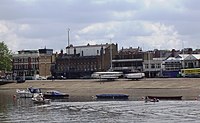|
Sons of the Thames
Sons of the Thames is a rowing club in Hammersmith, London, England. It was formed in Putney in 1886 with the aim, still enshrined in its constitution, to further the sport of rowing. HistoryOriginally a tradesmen's club, thus open to those in manual work, that boated from Erith, the club by the date of its formal constitution had moved up river to Putney, boating from the Duke's Head, and then to Hammersmith. The latest move, since 2000, shares there Linden House, on the promenade known as Upper Mall, with London Corinthian Sailing Club.[1] The sailing club enjoys a 999-year lease. The club welcomes novices and offers a Learn to Row course each summer. More experienced members and graduates moving on from university boat clubs are also very welcome and will be integrated into the training squads for Henley and other regattas. The club's official founding date is 1886,[2] however there is evidence of crews racing under the "Sons of the Thames" name at least as far back as 1865.[3] See also Joseph Sadler Crew Races. Possible connectionsIn 1861, Herbert Playford created the Sons of the Thames Regatta,[4] to bring forward new junior rowers. The race was held on the Thames between Putney and Hammersmith and had the distinction that the competitors must not use slides. [5] [6] There are also mentions of a society called Sons of the Thames Society formed before 1790 to celebrate the annual Doggett's Coat and Badge sculling race.[7] ResultsHenley Royal RegattaSons of the Thames enjoyed success in the 1960s, winning twice at Henley.[8]
Henley Women's RegattaSons of the Thames are the 2010 winners of the Frank Harry Cup at Henley Women's Regatta,[9] setting a new course record.[10]
British Championships
Dewar ShieldSons of the Thames, along with Auriol Kensington Rowing Club and Furnivall Sculling Club organise a yearly head race, the winners of which receive the Dewar Challenge Shield. The race covers half the Championship Course in the opposite direction, starting at Chiswick Bridge and finishing at Hammersmith Bridge. The shield is named after Alice Dewar, a Furnival Captain in 1909.[13] However, there are many other "Dewar Challenge Shields" that were presented by Sir Thomas Dewar dating from around the same time and which are very similar in design, so it's possible the origins of the shield may be different.[14][15] See alsoReferences
External links |
||||||||||||||||




